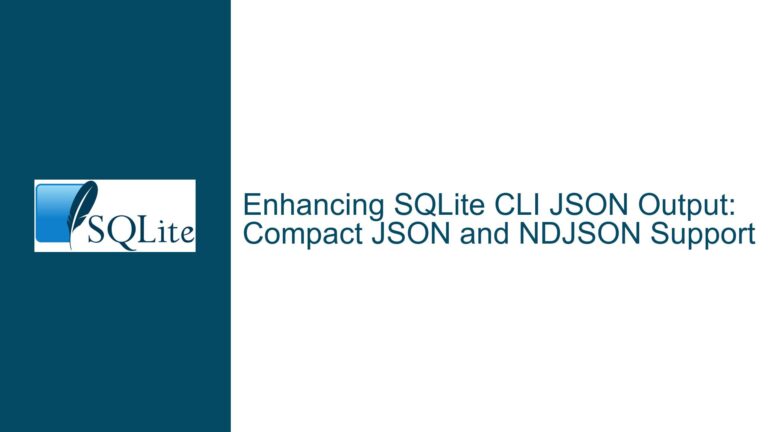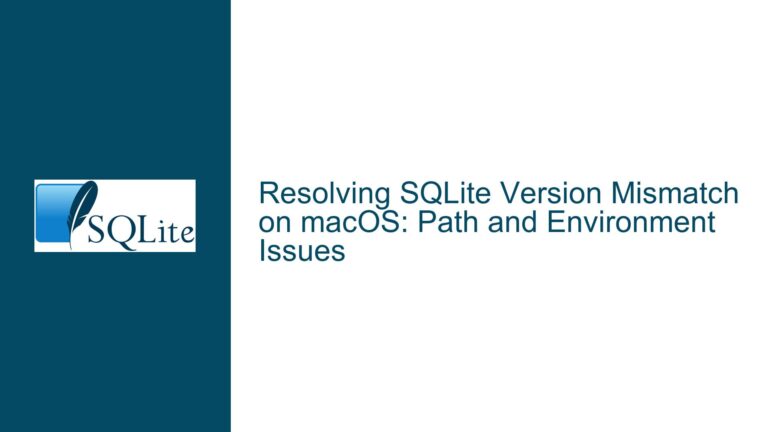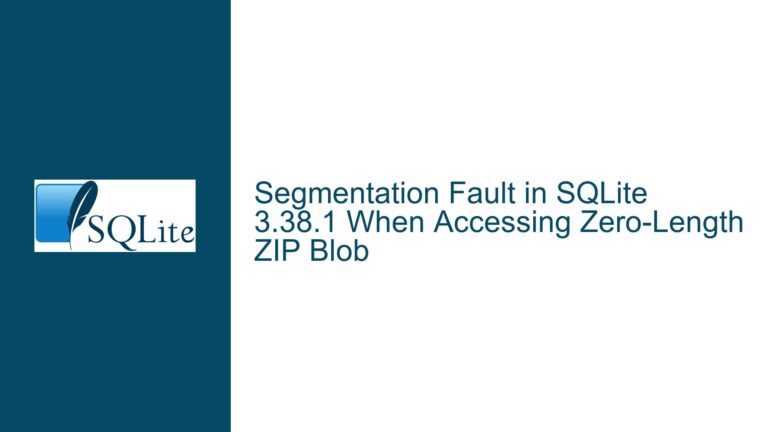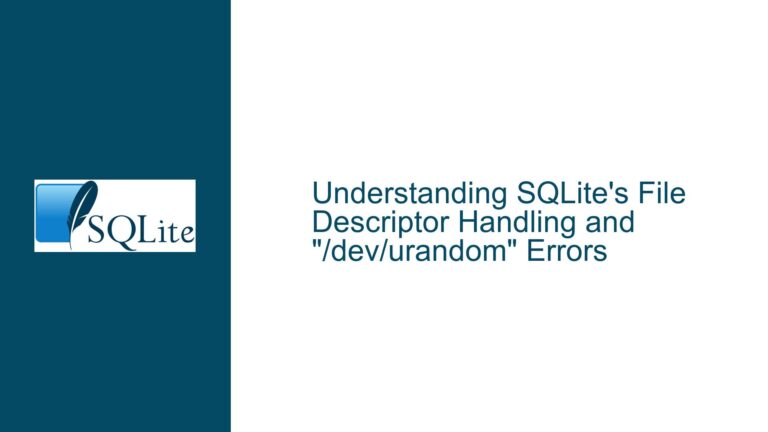SQLite JNI Bindings: Threading, Documentation, and Performance Optimization Challenges
Issue Overview: Threading Limitations, Documentation Gaps, and Performance Bottlenecks in SQLite JNI Bindings
The SQLite JNI (Java Native Interface) bindings introduced in version 3.43 present a set of challenges that primarily revolve around threading limitations, incomplete documentation, and performance bottlenecks, particularly in bulk operations. The JNI bindings aim to provide a 1-to-1 mapping of the SQLite C API to Java, enabling Java developers to leverage SQLite’s full feature set without the need for high-level object-oriented wrappers. However, this approach introduces several issues that need to be addressed to ensure a seamless experience for developers.
The threading limitations in the initial release of the JNI bindings are significant. The 3.43 version restricts SQLite API usage to a single Java thread at a time, which can severely limit the scalability and performance of multi-threaded Java applications. Although this limitation has been addressed in the current trunk version, which supports multiple Java threads, the initial release’s constraints highlight the importance of thorough testing and consideration of threading models in JNI-based solutions.
Documentation is another critical issue. The JNI bindings currently lack comprehensive Javadoc, which makes it difficult for developers to understand the API’s nuances and usage patterns. While the C API documentation can be used as a reference, the absence of Java-specific documentation, particularly for callback interfaces and custom SQL functions, creates a barrier to entry for Java developers who are not familiar with the C API. The documentation is currently embedded within the Java source files, and while there are plans to improve Javadoc compliance, the lack of hosted documentation on SQLite.org further complicates the situation.
Performance bottlenecks, particularly in bulk operations, are a third major issue. The JNI boundary introduces significant overhead, especially when performing bulk inserts or updates. Each JNI call to bind column values for individual rows can become a performance bottleneck, as the overhead of crossing the JNI boundary accumulates. This issue is exacerbated in garbage-collected languages like Java, where the cost of JNI calls is non-negligible. While some developers have implemented workarounds, such as batch binding methods, these solutions are not part of the official JNI bindings, leaving developers to fend for themselves when optimizing performance-critical operations.
Possible Causes: Threading Model, Documentation Strategy, and JNI Overhead
The threading limitations in the initial release of the JNI bindings can be attributed to the initial design choices made during the development of the bindings. The decision to restrict API usage to a single Java thread was likely a stepping stone to ensure stability and correctness before introducing multi-threaded support. However, this approach inadvertently created a significant limitation for developers who rely on multi-threaded applications to achieve high performance and scalability. The current trunk version’s support for multiple threads is a step in the right direction, but the initial release’s limitations underscore the importance of considering threading models early in the development process.
The documentation gaps stem from the project’s focus on providing a 1-to-1 mapping of the C API to Java. While this approach reduces the learning curve for developers familiar with the C API, it leaves Java developers who are not familiar with SQLite’s C API at a disadvantage. The lack of Javadoc and hosted documentation further exacerbates this issue, as developers are forced to navigate the source code to understand the API’s behavior. The ongoing efforts to improve Javadoc compliance and host the documentation on SQLite.org are positive steps, but the current state of the documentation remains a barrier to adoption.
The performance bottlenecks in bulk operations are a direct result of the JNI boundary’s overhead. Each JNI call introduces latency and reduces throughput, making it impractical to perform bulk operations using the same approach as in C. The SQLite API, designed for an embedded C environment, assumes that individual function calls are nearly free, but this assumption does not hold true when crossing the JNI boundary. The lack of batch binding methods in the official JNI bindings forces developers to implement their own optimizations, which can lead to inconsistencies and additional maintenance overhead.
Troubleshooting Steps, Solutions & Fixes: Enhancing Threading Support, Improving Documentation, and Optimizing Performance
To address the threading limitations, developers should ensure that they are using the latest trunk version of the JNI bindings, which supports multiple Java threads. If upgrading is not an option, developers can implement their own threading models to work around the single-thread limitation. For example, a thread pool can be used to serialize access to the SQLite API, ensuring that only one thread interacts with the API at a time. However, this approach can introduce additional complexity and may not be suitable for all use cases. The best long-term solution is to upgrade to the latest version of the JNI bindings, which provides full multi-threading support.
Improving the documentation is essential to making the JNI bindings more accessible to Java developers. The ongoing efforts to enhance Javadoc compliance and host the documentation on SQLite.org are positive steps, but developers can also take proactive measures to improve their understanding of the API. For example, developers can generate the Javadoc locally using the provided build instructions and use it as a reference. Additionally, developers can contribute to the documentation effort by submitting patches or suggestions for improving the Javadoc. The SQLite team has expressed openness to feedback, and community contributions can help accelerate the documentation process.
Optimizing performance in bulk operations requires addressing the JNI boundary’s overhead. Developers can implement batch binding methods to reduce the number of JNI calls, as suggested by some forum participants. For example, a batch binding method can pack multiple column values into a single buffer on the Java side and pass a pointer to this buffer over the JNI boundary. This approach minimizes the overhead of individual JNI calls and can significantly improve performance in bulk operations. While this solution requires additional effort, it can be implemented as a utility class or extension to the official JNI bindings. Developers should also consider using prepared statements and parameterized queries to further optimize performance.
In addition to these solutions, developers should be aware of the trade-offs involved in using the JNI bindings. While the 1-to-1 mapping of the C API to Java provides access to SQLite’s full feature set, it also introduces challenges related to threading, documentation, and performance. Developers should carefully evaluate their use case and consider whether the JNI bindings are the best fit for their needs. For example, developers who require high-level object-oriented APIs may prefer to use existing JDBC drivers or other wrapper libraries that provide a more Java-like interface.
In conclusion, the SQLite JNI bindings offer a powerful way to leverage SQLite’s capabilities in Java applications, but they also present several challenges that need to be addressed. By upgrading to the latest version of the bindings, improving the documentation, and optimizing performance in bulk operations, developers can overcome these challenges and make the most of SQLite’s features. The SQLite team’s commitment to feedback and community contributions provides an opportunity for developers to shape the future of the JNI bindings and ensure that they meet the needs of the Java community.






